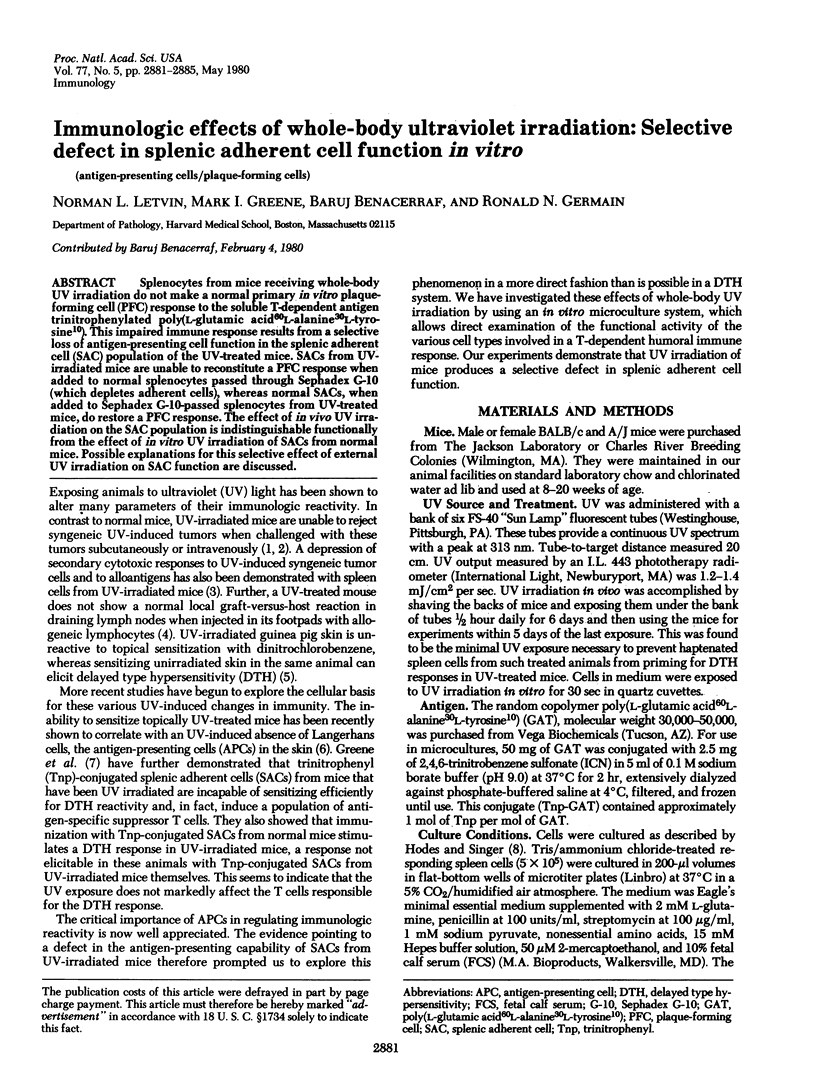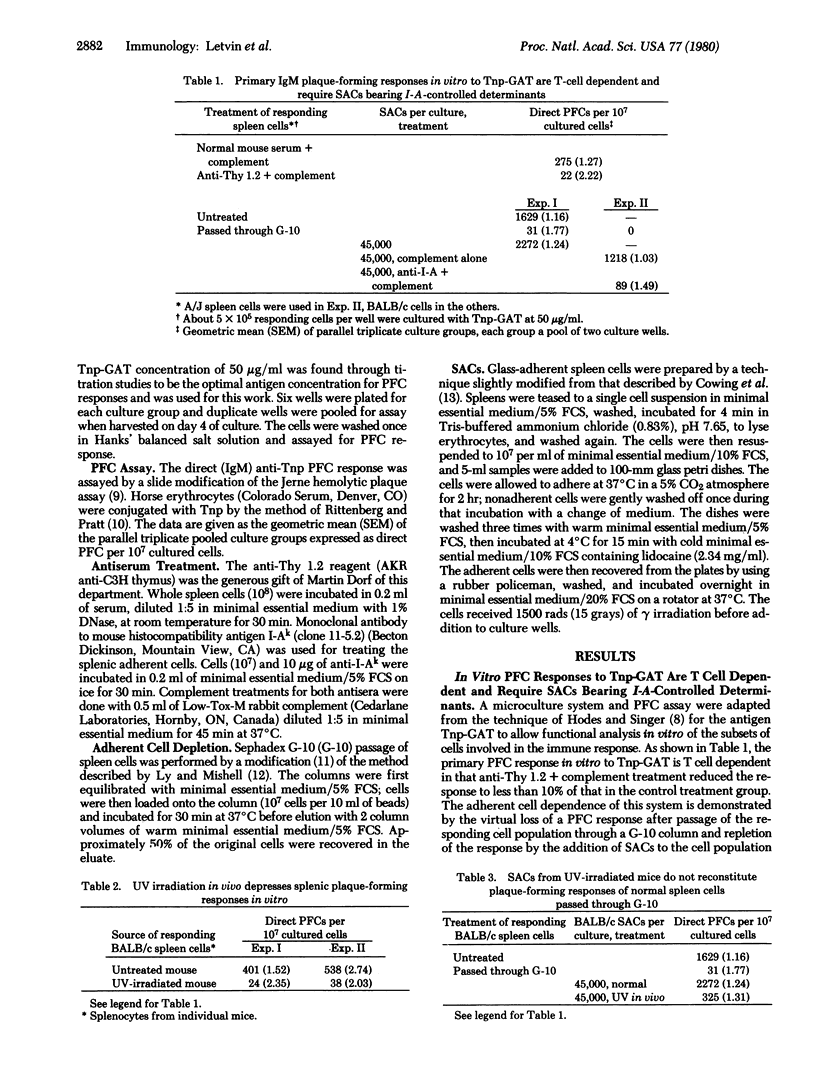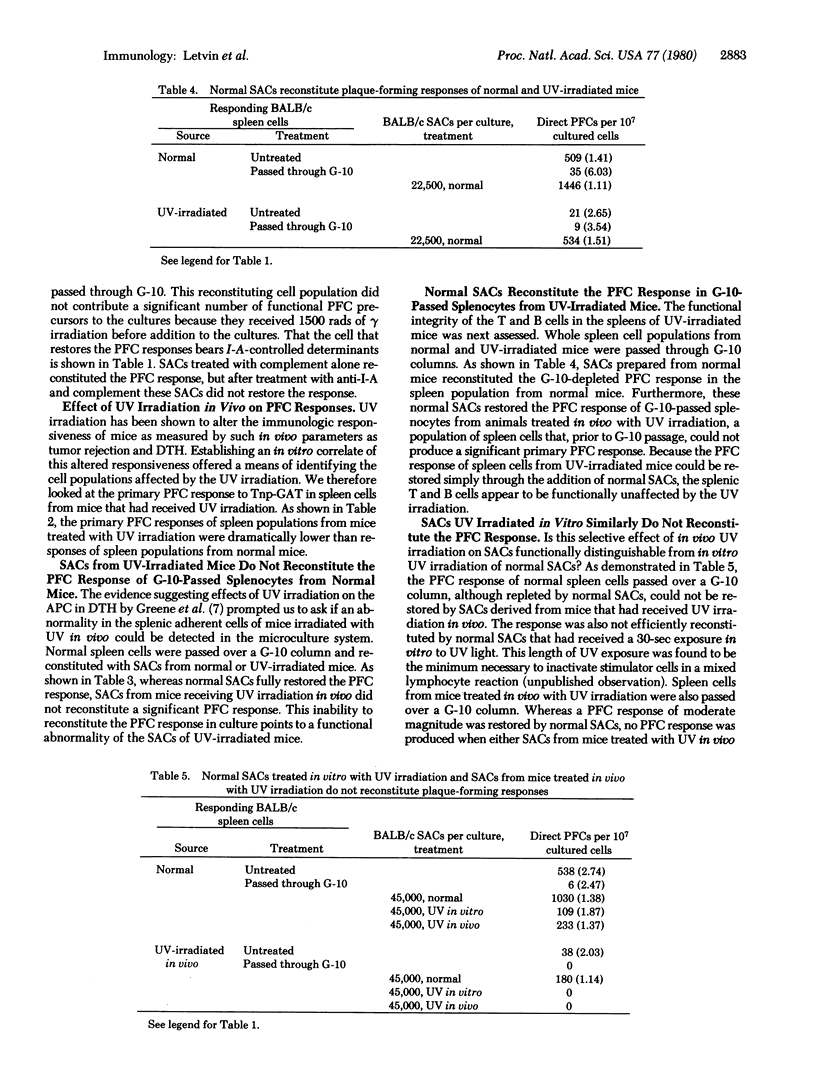Abstract
Splenocytes from mice receiving whole-body UV irradiation do not make a normal primary in vitro plaque-forming cell (PFC) response to the soluble T-dependent antigen trinitrophenylated poly(L-glutamic acid60L-alanine30L-tyrosine10). This impaired immune response results from a selective loss of antigen-presenting cell function in the splenic adherent cell (SAC) population of the UV-treated mice. SACs from UV-irradiated mice are unable to reconstitute a PFC response when added to normal splenocytes passed through Sephadex G-10 (which depletes adherent cells), whereas normal SACs, when added to Sephadex G-10-passed splenocytes from UV-treated mice, do restore a PFC response. The effect of in vivo UV irradiation on the SAC population is indistinguishable functionally from the effect of in vitro UV irradiation of SACs from normal mice. Possible explanations for this selective effect of external UV irradiation on SAC function are discussed.
Full text
PDF




Selected References
These references are in PubMed. This may not be the complete list of references from this article.
- Chen C., Hirsch J. G. The effects of mercaptoethanol and of peritoneal macrophages on the antibody-forming capacity of nonadherent mouse spleen cells in vitro. J Exp Med. 1972 Sep 1;136(3):604–617. doi: 10.1084/jem.136.3.604. [DOI] [PMC free article] [PubMed] [Google Scholar]
- Cowing C., Schwartz B. D., Dickler H. B. Macrophage Ia antigens. I. macrophage populations differ in their expression of Ia antigens. J Immunol. 1978 Feb;120(2):378–384. [PubMed] [Google Scholar]
- Fisher M. S., Kripke M. L. Further studies on the tumor-specific suppressor cells induced by ultraviolet radiation. J Immunol. 1978 Sep;121(3):1139–1144. [PubMed] [Google Scholar]
- Greene M. I., Sy M. S., Kripke M., Benacerraf B. Impairment of antigen-presenting cell function by ultraviolet radiation. Proc Natl Acad Sci U S A. 1979 Dec;76(12):6591–6595. doi: 10.1073/pnas.76.12.6591. [DOI] [PMC free article] [PubMed] [Google Scholar]
- HANISZKO J., SUSKIND R. R. The effect of ultraviolet radiation on experimental cutaneous sensitization in guineapigs. J Invest Dermatol. 1963 Apr;40:183–191. doi: 10.1038/jid.1963.35. [DOI] [PubMed] [Google Scholar]
- Hodes R. J., Singer A. Cellular and genetic control of antibody responses in vitro. I. Cellular requirements for the generation of genetically controlled primary IgM responses to soluble antigens. Eur J Immunol. 1977 Dec;7(12):892–897. doi: 10.1002/eji.1830071214. [DOI] [PubMed] [Google Scholar]
- Hoffmann M., Dutton R. W. Immune response restoration with macrophage culture supernatants. Science. 1971 Jun 4;172(3987):1047–1048. doi: 10.1126/science.172.3987.1047. [DOI] [PubMed] [Google Scholar]
- Kripke M. L., Fisher M. S. Immunologic parameters of ultraviolet carcinogenesis. J Natl Cancer Inst. 1976 Jul;57(1):211–215. doi: 10.1093/jnci/57.1.211. [DOI] [PubMed] [Google Scholar]
- Kripke M. L., Gruys E., Fidler I. J. Metastatic heterogeneity of cells from an ultraviolet light-induced murine fibrosarcoma of recent origin. Cancer Res. 1978 Sep;38(9):2962–2967. [PubMed] [Google Scholar]
- Kripke M. L. Ultraviolet radiation and tumor immunity. J Reticuloendothel Soc. 1977 Sep;22(3):217–222. [PubMed] [Google Scholar]
- Ly I. A., Mishell R. I. Separation of mouse spleen cells by passage through columns of sephadex G-10. J Immunol Methods. 1974 Aug;5(3):239–247. doi: 10.1016/0022-1759(74)90108-2. [DOI] [PubMed] [Google Scholar]
- Mishell R. I., Dutton R. W. Immunization of dissociated spleen cell cultures from normal mice. J Exp Med. 1967 Sep 1;126(3):423–442. doi: 10.1084/jem.126.3.423. [DOI] [PMC free article] [PubMed] [Google Scholar]
- Möller G., Lemke H., Opitz H. G. The role of adherent cells in the immune response. Fibroblasts and products released by fibroblasts and peritoneal cells can substitute for adherent cells. Scand J Immunol. 1976;5(3):269–280. doi: 10.1111/j.1365-3083.1976.tb00278.x. [DOI] [PubMed] [Google Scholar]
- Pierres M., Germain R. N. Antigen-specific T cell-mediated suppression. IV. Role of macrophages in generation of L-glutamic acid60-L-alanine30-L-tyrosine10 (GAT)-specific suppressor T cells in responder mouse strains. J Immunol. 1978 Oct;121(4):1306–1314. [PubMed] [Google Scholar]
- Rittenberg M. B., Pratt K. L. Antitrinitrophenyl (TNP) plaque assay. Primary response of Balb/c mice to soluble and particulate immunogen. Proc Soc Exp Biol Med. 1969 Nov;132(2):575–581. doi: 10.3181/00379727-132-34264. [DOI] [PubMed] [Google Scholar]
- Schwartz R. H., Yano A., Paul W. E. Interaction between antigen-presenting cells and primed T lymphocytes: an assessment of Ir gene expression in the antigen-presenting cell. Immunol Rev. 1978;40:153–180. doi: 10.1111/j.1600-065x.1978.tb00405.x. [DOI] [PubMed] [Google Scholar]
- Shevach E. M., Paul W. E., Green I. Histocompatibility-linked immune response gene function in guinea pigs. Specific inhibition of antigen-induced lymphocyte proliferation by alloantisera. J Exp Med. 1972 Nov 1;136(5):1207–1221. doi: 10.1084/jem.136.5.1207. [DOI] [PMC free article] [PubMed] [Google Scholar]
- Silberberg-Sinakin I., Thorbecke G. J., Baer R. L., Rosenthal S. A., Berezowsky V. Antigen-bearing langerhans cells in skin, dermal lymphatics and in lymph nodes. Cell Immunol. 1976 Aug;25(2):137–151. doi: 10.1016/0008-8749(76)90105-2. [DOI] [PubMed] [Google Scholar]
- Thorn R. M. Specific inhibition of cytotoxic memory cells produced against UV-induced tumors in UV-irradiated mice. J Immunol. 1978 Nov;121(5):1920–1926. [PubMed] [Google Scholar]
- Toews G. B., Bergstresser P. R., Streilein J. W. Epidermal Langerhans cell density determines whether contact hypersensitivity or unresponsiveness follows skin painting with DNFB. J Immunol. 1980 Jan;124(1):445–453. [PubMed] [Google Scholar]


